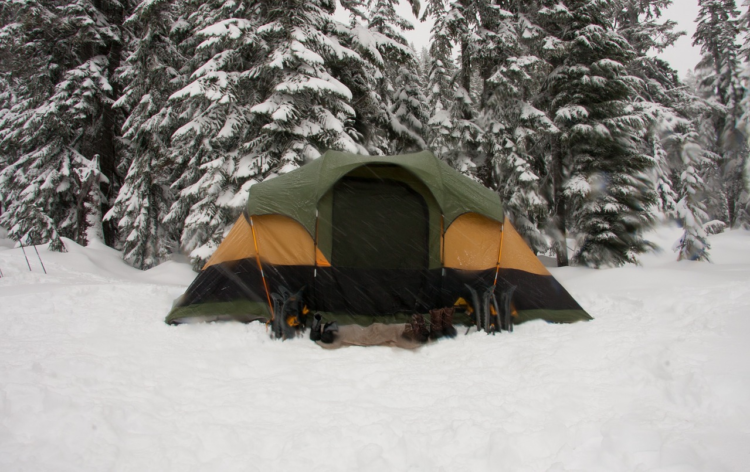How Do People Survive Cold Weather Camping?
Editor’s Note: if you are like Mai-Liis and can’t wait for the colder weather to return, here is an article that will keep you going. Cold Weather Camping is an activity that we know little about, but can benefit us greatly. Here are tips to plan your next trip.
Some people love winter; some people love camping, but not many love winter camping. People often see the disadvantages of camping in cold weather and overlook the advantages. Winter camping is calmer as fewer people are likely to camp during winter. You will find fewer bugs in winter and won’t need to use insect repellants. The scenery is different in winter; the sky looks brighter and the snow will give the mountains a majestic appearance.
We mentioned there are disadvantages to winter camping, as the cold weather, but luckily, there are ways to survive the cold weather when camping, and here they are.
Checking the Weather
Before embarking on your camping trip, it’s important to check the weather. Knowing what to expect is the best way to prepare well. You will want to avoid camping in a place or time where there’s a blizzard, windstorm, or polar-vortex breakout. In mountainous areas, it’s important to choose a place safe from avalanches. The weather can’t always be predicted accurately, so you must be prepared for everything.
Bringing the Right Gear
Another part of surviving camping in cold weather is to bring along the right gear. It will save you from situations you don’t want to be in. Here’s a list of things you must include in your camping gear checklist:
1. Tent
You probably already knew you need shelter in any season when camping. A tent is the best way to counter the cold, especially when asleep at night. A 3-season backpacking tent is good enough, unless you’re anticipating strong wind or heavy snow, then you should bring a 4-season tent. A 4-season tent is more sturdy and will resist powerful wind and heavy snow. Make sure your tent is roomy so that you have space to store your gear.
2. A Large Backpack
You’ll need more gear in winter than summer so it’s important to have a larger backpack. There are specialized backpacks for camping that allow you to carry everything you need easily, and it is also designed in a way that it distributes the weight so that you don’t have to deal with an aching back.
3. Sleeping Bag
You need a sleeping bag to, well, sleep. I bet you saw this one coming, but anyway, you won’t be able to sleep in a tent in the cold without a sleeping bag to keep you warm and snug. It’s important that you get the correct sleeping bag for the weather conditions that you are going to be camping in. Make sure you look up reviews and understand the specs before deciding on which one to purchase so that you have one that you will keep you warm enough. When you sleep well, you will wake up fresh and ready for your adventure.
4. Sleeping Pads
A sleeping pad is used to add cushioning to your sleeping bag and insulate it. In winter, you should use two full-length pads; one should be a foam pad underneath you and the other should be a self-inflating pad on top of you. It’s important to check the R-value, which is the measurement of insulation, of your pad. It measures from 1.0 to 8.0 and winter or all-season pad should be at 4.0 or higher R-value.
5. Backpacking Stove
There are two main types of backpacking stoves: liquid-fuel stoves and canister stoves.
Canister stoves are more compact, lightweight, and work faster. They require no priming, which is pre-heating. Their downsides are that they don’t work well in the winter and require a pressure regulator which will stop depressurizing and that causes the production of a weak flame. A liquid-fuel stove runs on white gas. It’s slower, heavier, and requires priming, but they work much better in cold weather than canister stoves. Remember to get a backup stove just in case the primary one malfunctions.
6. Layers of Clothes
You’re advised to wear 3 layers of clothes while winter camping. A base layer, close to your skin, should be made out of wool or polyester. The second layer serves to insulate and preserve your body heat; you can wear synthetic insulating jackets and pants, or fleece if you prefer. The third outer layer should be waterproof, but should also allow perspiration to leave your body. As for your shoes, you should bring snowshoes or skis or a snowboard if the area you’re in has heavy snow and if it doesn’t, mountaineering boots will do.
7. Avalanche Equipment
If the area you’re traveling is an avalanche train, you mustn’t go without this equipment: an avalanche transceiver, a probe, and a snow shovel. You should learn how to use them, especially the transceiver.
8. Food and Drink
It’s easier to forget to drink water in winter, but it’s very important to stay hydrated in winter to regulate your body temperature. You also need to eat enough food before you sleep to feel warm all through the night.
Being aware of the basics of winter camping will help you avoid danger and many troubles. It starts with checking the weather to knowing your gear and keeping yourself warm. Make sure to have a checklist of the gear you need to bring with you. Doing your research before going camping in cold weather is crucial to have a smooth and safe trip.





